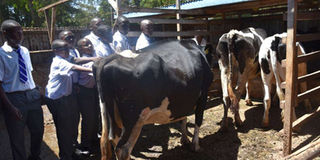Keep cows safe from heat stress

Uhuru-Kahuho Secondary School students in a dairy farm in their school in Kabete, Kiambu County. When farming dairy cattle, ensure they are comfortable from all adverse effects of heat, such as heat stress. PHOTO | ANTHONY OMUYA | NMG
What you need to know:
- Dairy cows suffer a lot from heat stress which occurs when a cow’s heat load is much greater than her capacity to lose it.
- Such cows normally congregate next to water troughs.
- Air flow into and out of the barn and between the cows is increased when walls of the barn are left open and roofs raised higher.
- Try to minimise stress when handling the cows and provide more clean and fresh water. These will improve comfort for the cows and attain good health, which is central to animal welfare.
A distressed farmer recently asked me why his two cows bought from Aberdares in Nyandarua County were only eating well in the morning and evening while during the day, they drunk a lot of water and breathed faster.
His dairy unit was soft bedded and his vet had not detected any disease, he added, wondering if he was sold sick cows.
Well, to begin with, cows communicate.
We only need to understand their language. The message from the two cows is quite clear, that they are suffering from heat stress.
Dairy cows suffer a lot this problem, which occurs when a cow’s heat load is much greater than her capacity to lose it. Heat stress is as a result of air temperature, humidity, solar radiation and air movement.
The ideal temperature range that makes dairy cows comfortable (thermos-neutral zone) is approximately between -4 to 24°C. One must not measure each time the temperature in the barn, but work on management towards ‘creating’ the optimum temperature.
Beyond thermos-neutral zones, over 25 to 27°C, cows respond by adapting different natural coping strategies.
Physiologically, they exhibit elevated breathing rates, panting, and reduce reproductive performance/fertility. Most likely, there is drop in milk production.
Behavioural coping strategies will include high water intake to cool their bodies, increased standing time, reduced activities and movement. Increased water intake is always seen in hot weather, particularly in high-yielders.
Besides shifting feeding times to cooler periods of the day like mornings and evenings, they will also eat less because high feed intake increases heat load in their bodies.
This reduction in feed intake also reduces the availability of nutrients used in milk synthesis, compromising milk quality too.
Such cows normally congregate next to water troughs. Remember, cows tend to gather where it is cool, so even when left to graze, they would prefer eating under trees to receive fresh air and keep their body cool from the canopy shades.
MINIMISE HEAT STRESS
Now, a farmer must help the cow adapt to its surrounding, the dairy barn/unit in this case. The first step in improving conditions for heat-stressed cows is by allowing good air flow.
Air flow into and out of the barn and between the cows is increased when walls of the barn are left open and roofs raised higher.
Low hanging roofs are closer to cows and are often extremely hot, remember, there are no ceiling boards. Just like humans don’t feel comfortable in low hanging roof houses, so are cows.
When air flow is limited in the barn, the environment becomes stagnant and stale to dangerous levels. Therefore, it is essential to have rapid air movement in any confined area within the barn.
Next provide shade over the feeding area, which will make the cows increase feeding time hence have higher feed intake. You may also need to modify the diet and mineral salts to maintain or increase feed intake.
At this point, feed higher quality forages since they are more digestible, contain more energy and produce less heat during fermentation compared to forage of poorer quality.
Try to minimise stress when handling the cows and provide more clean and fresh water. These will improve comfort for the cows and attain good health, which is central to animal welfare.
When heat stress gets to chronic levels, the cows may experience metabolic changes that can result in stress-related illnesses and lowered immunity.
The animals thus become susceptible to mastitis-causing pathogens leading to clinical mastitis and raised somatic cell counts in milk.
Opinya is based at the Department of Animal Sciences, Egerton University. He is the founder of The Udder, a dairy consultancy.





